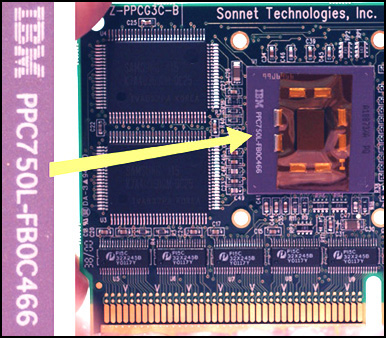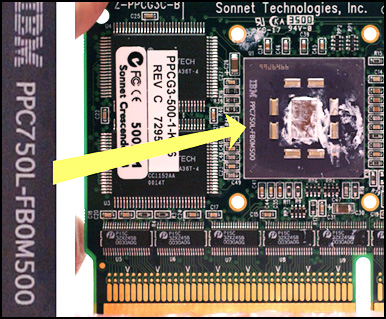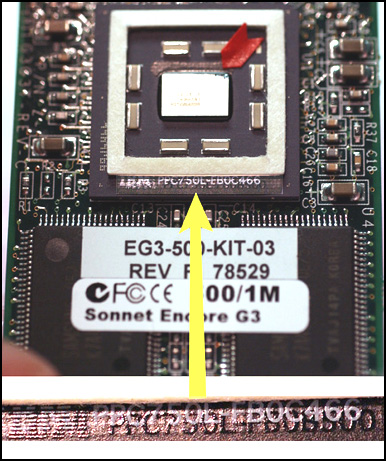| ID | | Article Title | Post Date |
|
69 | 
| What are the known incompatibilities with the Crescendo/7200 v1.1? | May-12-09 |
|
71 | 
| What type of RAM can I add to my Crescendo/7200 card? | May-12-09 |
| Sonnet has designed the Crescendo/7200 to utilize the same memory DIMMs that are used to upgrade the motherboard RAM in these popular Power Macintosh models. Sonnet recommends Fast Page Mode (FPM); 60 ns; 5 volt; 4K refresh; 168-pin DIMMs.
Compatible DIMMs are also available through most of Sonnet's wide channel of knowledgeable resellers.
Some 128MB DIMMs that employ an 8K refresh are known to pose potential problems. 128MB DIMMs are typically composed of 16 chips, each a 16Mx4 part. There are two types that are used, the "4K Refresh" and the "8K Refresh". The Crescendo/7200 is not compatible with some DIMMs made with "8K Refresh" parts because the timing margins are so thin that the electrical "noise" generated by the card causes errors. The "8K" versus "4K" parts can be identified by the part numbers of the chips on the DIMM, or by checking with the manufacturer of the chips. |
| |
|
85 | 
| System will not boot, or consistently crashes early in start-up. | Jan-28-10 |
|
171 | 
| The speed indicated on the G3 or G4 chip on my Sonnet processor upgrade doesn't seem to match the speed of the upgrade I purchased. What's the story? | May-07-09 |
| Sonnet sells and guarantees reliable products, as we have for over 20 years. We are always conservative with our customers' machines, and with how we select processors for our many upgrade products. We select processors based on the intended operating environment. Different applications have different cooling systems (heat sinks, fans, etc.), different airflow and different operating temperatures. Every chip has an operating space based on three parameters: speed, heat and voltage. The relationships between these parameters are well known by the chip manufacturers, and are communicated to OEM customers like Sonnet. A few examples are below.
Note: Despite the inclination to do so, you should never remove the heat sink from a Sonnet upgrade card. Breaking the thermal seal can result in erratic and unreliable performance if the seal is not perfectly re-established. In addition, Sonnet heat sinks are screwed down with a specific sequence and controlled torque. If this is not done correctly, it can result in a warped card, or even a cracked processor die. For these reasons, Sonnet's warranty is void if the heat sink has been removed.
Example 1: Desktop Macintosh solutions.
Apple specifies its current desktop models to operate at ambient temperatures up to 35 degrees Centigrade (95 degrees Fahrenheit). A G3 processor (with heat sink and airflow in these desktop systems) runs about 10 degrees C higher than ambient, so the resulting processor chip must run reliably at 35 + 10 = 45 degrees C.
Sonnet is conservative in all of its chip selections, and specifies processor operation to 65 degrees C. To ensure reliable supply, we qualify any appropriate available parts from the manufacturers that will operate in this environment. Processors have an inverse linear relationship between operating temperature and speed with a factor of 0.85 MHz per degree Celsius. In the case of a 500 MHz G3 Crescendo card, we have qualified two processors. One is a 65\u172\u8734 C G3 500 (designated by an "A" in front of the 500 in the part number), and the other is a 105\u172\u8734 C G3 466 (by a "C" before the 466). 466Mhz + (105\u172\u8734 C-65\u172\u8734 C) x 0.85MHz\u172\u8734 C = 500MHz at 65\u172\u8734 C. There is no compromise in chip life, reliability or performance, and except for the number stamped on top, there is no difference between these chips.
Why are chips marked differently? The makers need to supply solutions for different markets. Identical chips can be marked differently for commercial and industrial markets. When a part is incorrectly forecast, or if a customer cancels an order, the parts built for them may be offered to other markets. Sonnet qualifies and understands these alternate markings to allow quick use in the event that there are part delays, or if special purchase opportunities become available. Sonnet qualifies parts by stress-testing our products under extreme conditions. This allows us to offer reliable solutions with better part availability and often at lower prices.
In some cases, a chip manufacturer marks chips for one market and later overprints a different part number based on shifting market demand. Below are pictures of three equivalent parts with markings that illustrate the issue discussed above. The first is marked C466 (for 466 MHz @ 105\u172\u8734 C), the second is marked M500 (500 MHz @ 65\u172\u8734 C; "M" is a special symbol for a specific vertical market), and the third clearly shows a B500 (85\u172\u8734 C 500 MHz) part remarked as a C466. This clearly shows that the manufacturers trade off heat for speed on the same part.

Sample 1: Marked C466 (for 466 MHz @ 105\u172\u8734 C)

Sample 2: Marked M500 (500 MHz @ 65\u172\u8734 C)

Sample 3: Shows a B500 (85\u172\u8734 C 500 MHz) part remarked as a C466
Key Point: Because these parts are identical except for their markings, there is no compromise in reliability or product life.
Example 2: PowerBooks
PowerBooks have higher internal operating temperatures than desktop Macs, therefore Sonnet must provide extra margin to ensure reliable operation. On these models, Sonnet has qualified a 500 MHz "B" part (rated at 85\u172\u8734 C), and a 533 MHz "A" part (rated at 65\u172\u8734 C). In this case, chips may actually carry a speed marking that is higher than the speed of the Sonnet product to which they are attached! The speed marking alone is not enough. A G3 processors marked at 500 MHz, but rated at only 65\u172\u8734 C would be insufficient for reliable operation in a PowerBook.
Key Point: Sonnet selects parts based on their engineering specifications and their ability to perform as advertised, with generous margins. We do not take chances with our customers' machines.
Related Issue: In some cases, products of one specification may be stamped with an entirely different part number. At times, chip manufacturers have contracts to supply low-speed parts for extended periods, even after it is no longer cost effective to continue making the relatively slow parts. It is common practice in these cases to place the obsolete part's marking on a higher-speed part to fill the contract and to avoid any pricing conflicts in the market. In some rare cases, the parts marked for these sales become available to other customers, and if the tested specification is communicated and confirmed through testing, then we may use them in appropriate applications.
Example 3: Crescendo/PPC G3 450 1M
Some of these products have been reported to carry 333MHz processors. This is not correct. These parts are 85\u172\u8734 C 450MHz processors (designated by a "B"). They were remarked as 333MHz for a low-end customer that did not take them all. Sonnet purchased them with the information provided by the manufacturer that they were 450MHz processors. Sonnet waived the time and expense associated with remarking them again as 450MHz. On close inspection, the original part number can be seen, screened over on the surface of the chip. The photograph below clearly shows the over-stamp and the fully readable original tested marking covered beneath. |
| |
|
177 | 
| System will not boot, or consistently crashes early in start-up with a Crescendo/7200 upgrade card installed in computer. | May-07-09 |
| Issue 1: There are specific memory requirements for proper operation of this innovative upgrade. While these are documented in the Crescendo/7200 quick start guide, they may have been overlooked, so please review the solution below carefully.
Issue 2: Sonnet has determined that certain memory DIMMs are less stable than others when used with early production units of the Crescendo/7200 solution. Sonnet has since released both hardware and software updates to provide compatibility with a greater variety of memory. If implementing the solutions recommended for Issue 1 is not effective, you may be encountering a memory compatibility issue.
Solution for Issue 1 (all three must be followed):
1) DIMMS used for RAM expansion should be: 5 volt, 64-bit-wide, 168 pin, fast-page mode, and 70 ns or faster (smaller numbers are faster).
2) Total RAM installed on the Crescendo/7200 card must be equal to or greater than the RAM installed on the Power Macintosh motherboard.
3) In order to run System 7.5.3 through Mac\u172\u198 OS 8.6, there must be a minimum of 16 MB RAM on the motherboard, with equal or greater memory on the Crescendo card. In order to run Mac OS 9.0 through 9.1, a minimum of 32 MB is required on the motherboard, with an equal or greater amount on the Crescendo. While Sonnet plans to bring OS X to the Crescendo/7200, no final announcements have been made, and no RAM requirements have been defined at this time.
If you have satisfied all of the above conditions and are still experiencing problems, please proceed to the following solution.
Solution for Issue 2: Make sure you are using the latest Crescendo/7200 software.
Locate the serial number label on the back edge of the card on the side opposite the DIMM slots. If your Crescendo/7200 has a serial number that begins with an A (e.g. Axxxx), you are eligible for a free upgrade of your hardware that will provide compatibility with a wider array of memory DIMMs; contact Sonnet Customer Service at 1-949-472-2772 for instructions on returning it for this revision. If your card has a serial number that begins with a B, this revision is unnecessary; your card was manufactured with the latest updates.
If your card falls outside the identified ranges, and you continue to experience problems, call Customer Service at 1-949-472-2772 for further assistance. |
| |
|
218 | 
| The computer's standard startup process takes noticeably longer after upgrading to any Mac OS 9.x system from Mac OS 8.6 or earlier. | May-12-09 |
|
221 | 
| After installing the Sonnet Crescendo/7200 into a machine with two other PCI cards, or adding an additional PCI card to a machine already running the 7200 upgrade, the computer does not boot past the "Happy Mac" icon. If I remove either one of the PCI cards or the upgrade, the computer will boot without a problem. The same is true if I boot up holding down the SHIFT key to boot with extensions off. | May-07-09 |
|
222 | 
| After installing the Sonnet Crescendo/7200 into my machine, making sure I followed the instructions on RAM distribution, the computer does not boot past the "Happy Mac" icon. If I remove the 7200 upgrade, the computer will boot without a problem. The same is true if I boot up holding down the SHIFT key to boot with extensions off. | Aug-06-09 |
| The problem may be that one or more of the RAM chips that are installed on the logic board of the computer are 8MB DIMMs.
With previous versions of the Crescendo/7200 enabler, having 8MB DIMMs on the logic board was known to occasionally cause a conflict. With the release of the 7200 enabler version 1.1, Sonnet expands its support of RAM running on both the upgrade card and the logic board. To update to version 1.1, remove the 7200 upgrade processor and boot the computer. Then download the software. Once downloaded, run through the installation. The installer will remove any old version of the enabler that is currently installed and install version 1.1. When the installer is done, shut the computer down, reinsert the 7200 upgrade processor, and boot the computer normally.
|
| |
|
223 | 
| After installing the Sonnet Crescendo/7200 into a machine with 128MB RAM DIMMs, or adding 128MB RAM DIMMs to the machine that already was running the 7200 upgrade, the computer does not boot past the "Happy Mac" icon. The DIMMs work when installed alone on the logic board without the 7200 upgrade installed. If I remove either the 128MB RAM DIMMs or the processor upgrade, the computer will boot without a problem. The same is true if I boot up holding down the SHIFT key to boot with extensions off. | May-07-09 |
| |